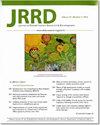Implementation of telementoring for pain management in Veterans Health Administration: Spatial analysis.
Q Medicine
Journal of Rehabilitation Research and Development
Pub Date : 2016-01-01
DOI:10.1682/JRRD.2014.10.0247
引用次数: 17
Abstract
In 2011, the Veterans Health Administration (VHA) implemented a pilot telementoring program across seven healthcare networks called the Specialty Care Access Network-Extension for Community Healthcare Outcomes (SCAN-ECHO) for pain management. A VHA healthcare network is a group of hospitals and clinics administratively linked in a geographic area. We created a series of county-level maps in one network displaying (1) the location of Veterans with chronic pain, (2) VHA sites (i.e., coordinating center, other medical centers, outpatient clinics), (3) proportion of Veterans being seen in-person at pain specialty clinics, and (4) proportion of Veterans with access to a primary care provider participating in Pain SCAN-ECHO. We calculated the geodesic distance from Veterans' homes to nearest VHA pain specialty care clinics. We used logistic regression to determine the association between distance and Pain SCAN-ECHO primary care provider participation. Mapping showed counties closer to the Pain SCAN-ECHO coordinating center had a higher rate of Veterans whose providers participated in Pain SCAN-ECHO than those further away. Regression models within networks revealed wide heterogeneity in the reach of Pain SCAN-ECHO to Veterans with low spatial access to pain care. Using geographic information systems can reveal the spatial reach of technology-based healthcare programs and inform future expansion.退伍军人健康管理中疼痛管理的远程监控实施:空间分析。
2011年,退伍军人健康管理局(VHA)在七个医疗保健网络中实施了一项试点远程监控计划,称为社区医疗保健结果专业护理访问网络扩展(SCAN-ECHO),用于疼痛管理。VHA医疗保健网络是一组在行政上连接在一个地理区域内的医院和诊所。我们在一个网络中创建了一系列县级地图,显示(1)患有慢性疼痛的退伍军人的位置,(2)VHA站点(即协调中心,其他医疗中心,门诊诊所),(3)在疼痛专科诊所亲自就诊的退伍军人比例,以及(4)参与疼痛扫描- echo的退伍军人获得初级保健提供者的比例。我们计算了从退伍军人之家到最近的VHA疼痛专科护理诊所的测地线距离。我们使用逻辑回归来确定距离与疼痛扫描-回声初级保健提供者参与之间的关系。地图显示,距离疼痛扫描- echo协调中心较近的县,其医疗服务提供者参与疼痛扫描- echo的退伍军人比例高于距离较远的县。网络内的回归模型揭示了疼痛扫描回声对低空间获取疼痛护理的退伍军人的影响范围具有广泛的异质性。使用地理信息系统可以揭示基于技术的医疗保健计划的空间范围,并为未来的扩展提供信息。
本文章由计算机程序翻译,如有差异,请以英文原文为准。
求助全文
约1分钟内获得全文
求助全文

 求助内容:
求助内容: 应助结果提醒方式:
应助结果提醒方式:


